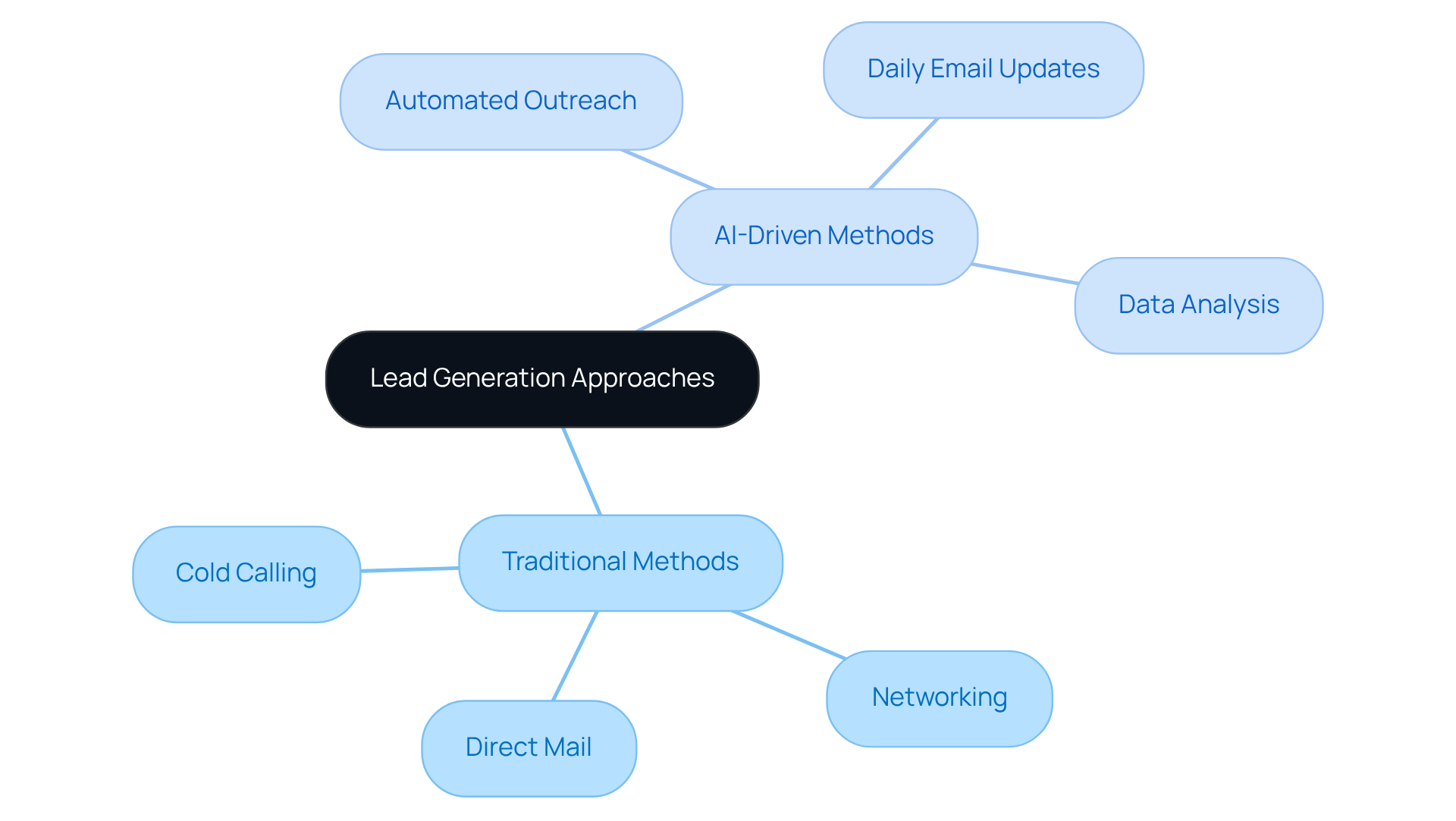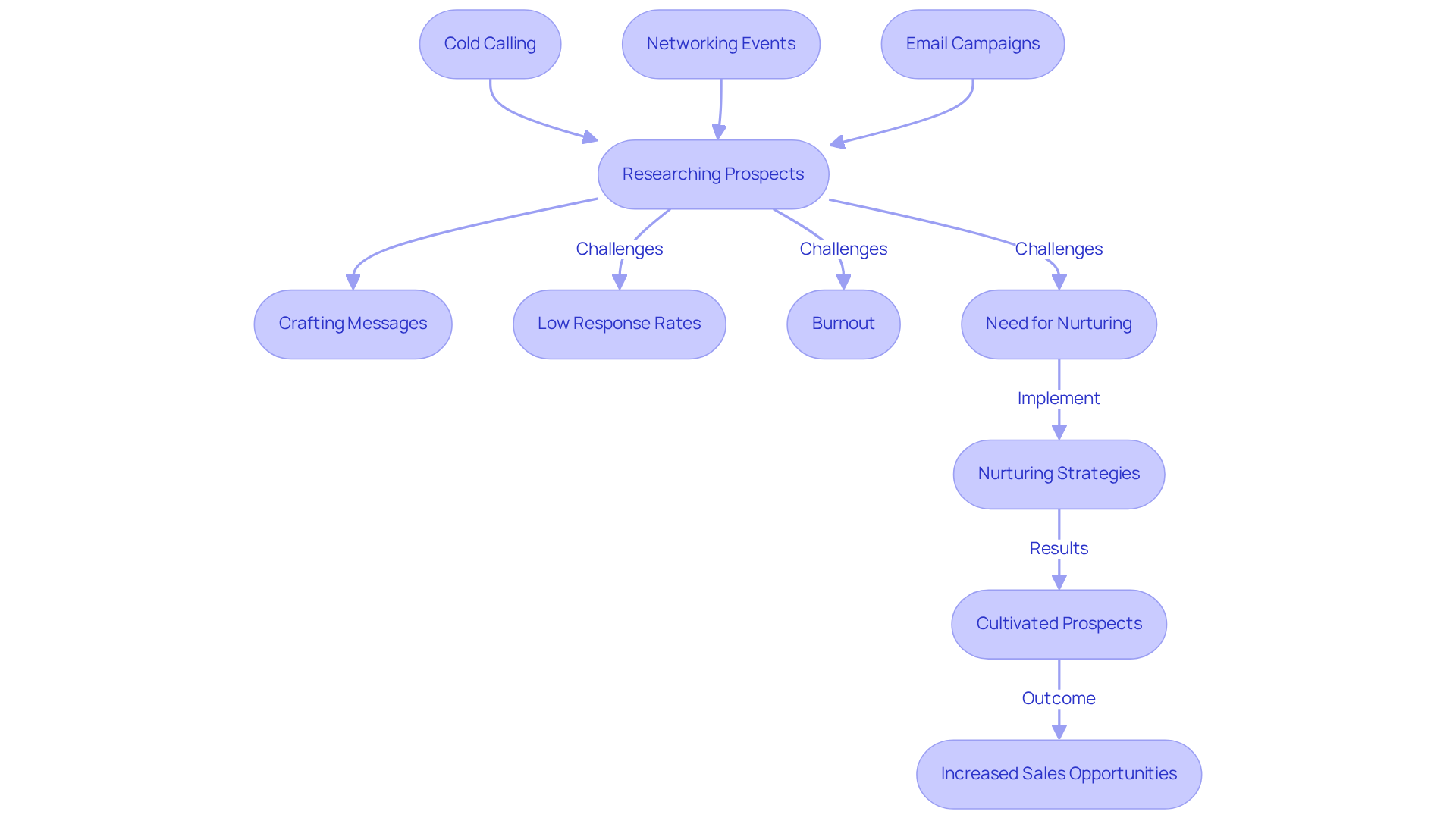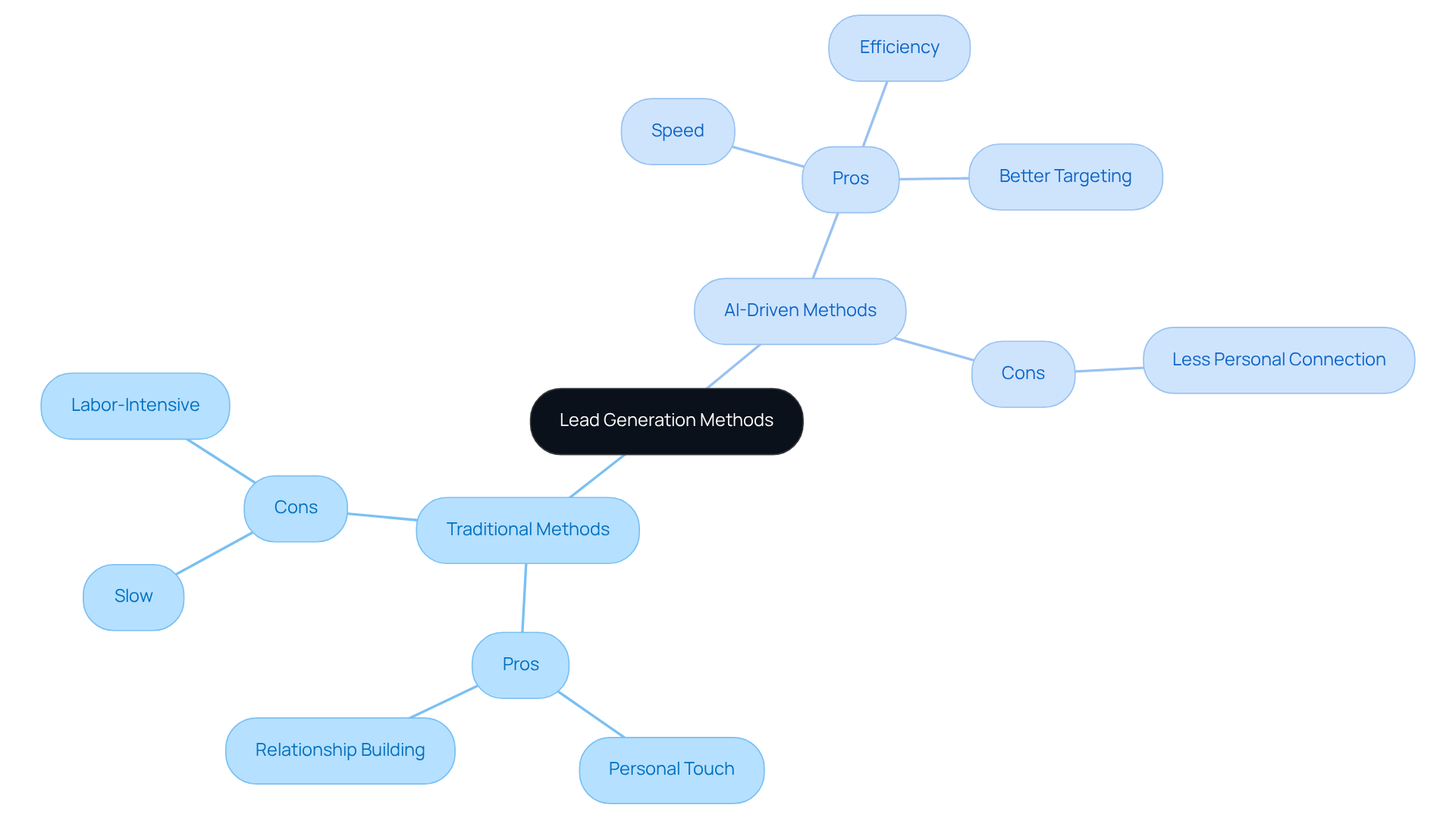Overview
In this article, we explore the differences between traditional lead generation methods—like cold calling and networking—and innovative AI-driven approaches that automate and enhance outreach processes. While traditional methods can help foster personal connections, they often require significant time and effort, making them less scalable for your growing business. On the other hand, AI-driven solutions can dramatically improve efficiency and targeting, ultimately leading to better prospect acquisition and higher conversion rates.
We understand your challenges in navigating these options. Imagine having the ability to connect with potential clients more effectively, without sacrificing the personal touch that matters so much. By embracing AI-driven strategies, you can streamline your outreach efforts, allowing you to focus on building those meaningful relationships that contribute to your success.
As you consider these approaches, think about how much more you could achieve with tools that enhance your capabilities. Together, we can explore solutions that not only meet your needs but also empower you to thrive in a competitive landscape. Let's take this step towards a more efficient future, where your business can flourish without the burden of outdated methods.
Introduction
The landscape of lead generation is evolving, and we understand that many businesses feel torn between traditional methods and innovative AI-driven solutions. While conventional strategies like cold calling and networking have long been the backbone of customer acquisition, they often come with significant challenges, such as time consumption and low response rates. This article explores the strengths and weaknesses of both approaches, revealing how AI technologies can streamline and enhance the lead generation process.
As you weigh the effectiveness of these contrasting methods, consider this question: can AI truly replace the personal touch of traditional outreach, or is there a way to integrate both for optimal results? Together, we can navigate this journey toward more effective lead generation.
Understanding Lead Generation: Traditional vs. AI-Driven Approaches
Customer acquisition is a vital method for attracting and transforming prospective buyers into valuable contacts, and lead gen services play a crucial role in this process. Traditional approaches to engaging potential clients often involve hands-on outreach strategies, such as:
- Cold calling
- Networking
- Direct mail
While these methods can be effective, they rely heavily on human effort, making them time-consuming and resource-intensive. Have you ever felt overwhelmed by these demands?
In contrast, lead gen services driven by AI, like those offered by Wayy, harness technology to automate and enhance the outreach process. With features such as daily email updates that provide key metrics on how many prospects were reached, who expressed interest, and improvements in conversion rates, Wayy empowers small business owners to see exactly what works each day. These updates include specific metrics, such as the number of new contacts generated, engagement rates, and trends in conversion rates, enabling informed decision-making.
Imagine having AI tools that analyze vast amounts of data to identify potential opportunities, predict actions, and connect with prospects at the right moment. This greatly enhances both efficiency and effectiveness. As we explore how these two approaches differ in methodology, speed, and scalability, it’s essential to recognize their respective strengths and weaknesses. Together, we can navigate these choices and find the best path forward for your business.

Exploring Traditional Lead Generation Methods: Processes and Challenges
Acquiring prospects through conventional methods like cold calling, networking events, and email campaigns can be overwhelming and time-consuming. Many sales teams find themselves tirelessly researching prospects and crafting personalized messages, which often leads to frustration. The challenges associated with these approaches are significant: response rates tend to be low, with many prospects declining outreach efforts. This can create a high level of burnout among sales teams. In fact, statistics reveal that 61% of marketers consider generating prospects their primary challenge, a concern that weighs heavily on small enterprises that may not have the resources to sustain such efforts.
Moreover, it's important to recognize that 73% of prospects are not ready to engage in sales conversations right from the start. This highlights the critical need for nurturing strategies. Small business owners often find themselves struggling to generate prospects efficiently with lead gen services, which can lead to missed opportunities and stagnant growth. However, it’s encouraging to note that cultivated prospects yield 20% more sales opportunities than those who are not nurtured. This underscores the potential benefits of adopting more effective lead gen services for outreach strategies.
Understanding these challenges is vital. Together, we can explore more efficient solutions that address these pressing needs in today’s competitive marketplace. By acknowledging the difficulties and focusing on nurturing relationships, we can pave the way for greater success and growth.

Leveraging AI-Driven Solutions: Transforming Lead Generation for Small Businesses
AI-powered prospect generation tools, such as Wayy.ai, are transforming the outreach process, allowing small enterprise owners to focus on what truly matters—their core activities. These innovative platforms use advanced algorithms to analyze data, identify potential prospects, and engage them at just the right moments. For instance, by monitoring purchase intent signals, businesses can connect with prospects when they are most likely to convert, significantly enhancing engagement.
Moreover, AI-driven solutions facilitate personalized outreach at scale, ensuring that communications are not only relevant but also impactful. This dual strategy increases the number of prospects generated while enhancing their quality, ultimately leading to higher conversion rates. Notably, Wayy.ai empowers users to create over 60 target client connections each month, showcasing its efficiency in improving prospect acquisition. With a subscription plan of just $99 monthly, it offers an affordable option for small enterprises.
By harnessing the capabilities of AI, small businesses can refine their lead gen services, making them more efficient and effective in prospect acquisition strategies. Additionally, Wayy.ai continuously learns from every interaction, allowing it to adapt and enhance its strategy over time. This ongoing support helps small business owners navigate the challenges of prospect acquisition and outreach management.
Are you ready to transform your client acquisition process? Get started with Wayy.ai today and experience the difference together!
Comparative Analysis: Pros and Cons of Traditional vs. AI-Driven Lead Generation
When we compare traditional approaches to lead gen services and AI-driven methods, it’s important to recognize both their advantages and disadvantages. Traditional methods often bring a personal touch and foster relationship-building, which can be essential in industries where trust is crucial. However, these methods can be slow, labor-intensive, and less scalable, leaving many small business owners feeling overwhelmed.
On the other hand, lead gen services that utilize AI-driven strategies offer remarkable speed and efficiency. They allow for the analysis of large datasets, enabling better targeting of potential leads. This can significantly reduce the time spent on manual tasks, ultimately enhancing the quality of prospects through insightful data. Yet, it’s worth noting that an over-reliance on technology might create a gap in personal connection, which can be a concern in certain situations.
Ultimately, the decision between these methods hinges on your specific needs and resources, particularly in the context of lead gen services and the nature of your target market. Reflect on what truly matters for your business. Together, we can navigate these choices to find the right balance that suits your unique situation.

Conclusion
In the landscape of customer acquisition, the choice between traditional and AI-driven lead generation services is pivotal. We understand that while traditional methods offer a personal touch and foster essential relationships, they can also be labor-intensive and slow. On the other hand, AI-driven solutions streamline the outreach process, leveraging technology to enhance efficiency and effectiveness. This transformation is crucial for small businesses seeking to improve their approach to lead generation.
Reflecting on the significant challenges associated with traditional lead generation, such as low response rates and the overwhelming nature of manual outreach efforts, we see a clear contrast with the advantages of AI-driven tools. These innovative solutions provide actionable insights, automate processes, and enable personalized outreach at scale. By adopting AI solutions, small business owners can not only increase their prospect acquisition but also improve the quality of their leads, paving the way for higher conversion rates.
As we consider these insights, it becomes clear that the future of lead generation lies in finding a balance between the personal connections fostered by traditional methods and the efficiency provided by AI technologies. Together, as businesses navigate these choices, embracing AI-driven solutions like Wayy.ai could be the key to unlocking new opportunities and achieving sustainable growth in an increasingly competitive market. We believe that by taking this step, you can transform your lead generation strategy and foster lasting success.
Frequently Asked Questions
What is lead generation and why is it important?
Lead generation is the process of attracting and transforming prospective buyers into valuable contacts, which is crucial for customer acquisition.
What are traditional approaches to lead generation?
Traditional lead generation methods include cold calling, networking, and direct mail, which involve hands-on outreach strategies.
What are the downsides of traditional lead generation methods?
Traditional methods are often time-consuming and resource-intensive, relying heavily on human effort.
How do AI-driven lead generation services differ from traditional methods?
AI-driven lead generation services automate and enhance the outreach process, making it more efficient and effective compared to traditional methods.
What features do AI-driven lead generation services offer?
AI-driven services, like those offered by Wayy, provide daily email updates with key metrics on prospects reached, expressed interest, and conversion rates, helping business owners make informed decisions.
How can AI tools improve lead generation?
AI tools analyze vast amounts of data to identify potential opportunities, predict actions, and connect with prospects at optimal times, enhancing efficiency and effectiveness.
What should businesses consider when choosing between traditional and AI-driven lead generation?
Businesses should evaluate the strengths and weaknesses of each approach, considering factors such as methodology, speed, and scalability to determine the best path forward.




